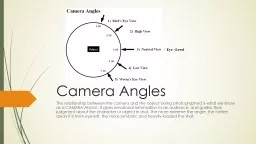

is what we know as a CAMERA ANGLE It gives emotional information to an audience and guides their judgment about the character or object in shot The more extreme the angle the further away it is from eye ID: 646503
Download Presentation The PPT/PDF document "Camera Angles The relationship between t..." is the property of its rightful owner. Permission is granted to download and print the materials on this web site for personal, non-commercial use only, and to display it on your personal computer provided you do not modify the materials and that you retain all copyright notices contained in the materials. By downloading content from our website, you accept the terms of this agreement.
Slide1
Camera Angles
The relationship between the camera and the object being photographed is what we know as a CAMERA ANGLE. It gives emotional information to an audience, and guides their judgment about the character or object in shot. The more extreme the angle, the further away it is from eye left, the more symbolic and heavily-loaded the shot.
/ Eye –Level Slide2
Birds Eye
This shows a scene from directly overhead, a very unnatural and strange angle. Familiar objects viewed from this angle might seem totally unrecognizable at first (umbrellas in a crowd etc
). This shot does, however, put the audience in a godlike position, looking down on the action. People can be made to look insignificant, ant-like, part of a wider scheme of things. In Film, Hitchcock is fond of this style of shot.Slide3
High Angle
Not so extreme as a bird's eye view. The camera is elevated above the action using a crane to give a general overview. High angles make the object photographed seem smaller, and less significant (or scary).
The object or character often gets swallowed up by their setting - they become part of a wider picture.
A cameraman, raised above the action, gets a high angle shotSlide4
Eye Level
A fairly neutral shot; the camera is positioned as though it is a human actually observing a scene, so that subject is positioned at a level with focus. The camera will be placed approximately five to six feet from the
ground in this case in perspective with the height of an adult. Slide5
Low Angle + Worm’s Eye View
These increase height and gives a sense of speeded motion. In cinematography, a low-angle shot, is a shot from a camera angle positioned low on the vertical axis, anywhere below the eye line, looking up. Sometimes, it is even directly below the subject's feet
. Psychologically, the effect of the low-angleshot is that it makes the subject look strong and powerful.
The background of a low angle shot will tend to be just sky or ceiling, the lack of detail about the setting adding to the disorientation of the viewer.
The
added height of the object may make it inspire fear and insecurity in the viewer, who is psychologically dominated by the figure on the screen.
ANGLE FROM DIRECT FROM GROUND: A
worm's-eye view is a view of an object from below, as though the observer were a worm; the opposite of a bird's-eye
view. As you can see the image on the far left would be considered an Worm’s-Eye View. Slide6
Oblique/Canted
Sometimes the camera is tilted (ie is not placed horizontal to floor level), to suggest imbalance, transition and instability (very popular in horror movies).This technique is used to suggest POINT-OF-View shots (ie when the camera becomes the 'eyes' of one particular character, seeing what they see — a hand held camera is often used for this.Slide7
OKAY STUDENTS! NOW LETS PUT WHAT YOU LEARNED INTO PRACTICE
YOUR TURN!
GUESS WHAT TYPE OF ANGLE IS THE FOLLOWING IMAGE…..Slide8